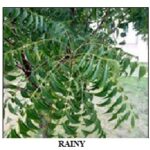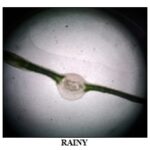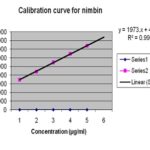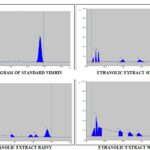IMPACT OF SEASONAL VARIATIONS ON NIMBIN ALKALOID FROM AZADIRACHTA INDICA A.
HTML Full TextIMPACT OF SEASONAL VARIATIONS ON NIMBIN ALKALOID FROM AZADIRACHTA INDICA A.
G. Palshikar 1 and P. S. Pandiyan * 2
PRIST Deemed to be University 1, Thanjavur - 613403, Tamil Nadu, India.
School of Pharmacy 2, Sathyabama Institute of Science & Technology, Deemed to be University, Chennai - 600119, Tamil Nadu, India.
ABSTRACT: Objective: Plants live on a planet with days and seasons, affecting their phytoconstituents. The challenge is that availability of active principles in medicinal plants changes by seasonal fluctuations, so their dose pattern for therapeutic efficacy also get influenced. The best duration for the harvesting of specific secondary metabolites for better yield is not fixed. Seasonal impact show changes in important constituents like polyphenol, flavonoids, glycosides, alkaloids, essential oil, etc. Late summer is the best collection time for essential oil components. Winter and rainy are the best season for other secondary metabolites. Methods: The selected plant Azadirachta indica A. belongs to the alkaloidal category with having anti-diabetic activity. Plants were evaluated for pharmacognostic study, which includes macroscopic and microscopic evaluation, determining physicochemical parameters systematically. HPTLC fingerprinting for nimbin was done. The study was performed for plant material with three different seasons, and the best results were analyzed. Results and Conclusion: All the plants showed correct taxonomy with specific morphological, microscopical, and physicochemical parameters, which is helpful for the standardization of drugs. Extracts showed the presence of alkaloids, terpenes, flavonoids, steroids, phenolics, saponin, and carbohydrates. HPTLC fingerprinting confirmed the presence of nimbin in the plant extracts. Seasonal variations occur in plant constituent shows best collection period. Current research aims to focus on the best possible season for the harvesting of some pharmaceutically important plant materials.
| Keywords: |
Secondary metabolites, Herbal medicines, Alkaloids, Antidiabetic, Seasonal variations
INTRODUCTION: Medicinal plants have been used in traditional treatments for numerous human diseases for thousands of years, and they continue to be an important therapeutic aid for alleviating the ailments of humankind.
In India, it is estimated that 80% of the population depends on plants to therapy themselves; of those, about 60% populace use medicinal plants habitually to battle certain ailments, and almost 40% of humans use such plants in pharmaceutical industries 1.
The World Health Organization (WHO) has outlined herbal medicine as culminated labeled medicinal products that incorporate lively ingredients as aerial or underground accessories of plants of the 2,50,000 higher plant species on earth, more than 80000 species are reported to have at least some medicinal value 2, 3. Since ages, humans have relied on nature for their basic needs for the production of foodstuff, shelters, clothing, means of transportation, fertilizers, flavors and fragrances, and medicines. Plants have formed the basis of sophisticated traditional systems of medicine that have been in existence for thousands of years and continue to provide humankind with new remedies 4. The history of herbal medication is equally old as human history. Most of these plant-derived drugs were originally identified through the subject of traditional remedies, and folk knowledge of indigenous people, and some of these could not be substituted despite the tremendous progress in synthetic chemistry.
Therefore, plants can be depicted as a major source of medicines, not merely as isolated active principles in standardized dosage form but also as crude drugs for the population. Modern medicines and herbal medicines are complimentary being used in areas for health care programs in various developing countries, including India 5. In the present scenario, the demand for herbal products is growing exponentially throughout the globe, and major pharmaceutical companies are currently carrying on extensive research on plant materials for their potential medicinal value 6, 7. The need for new therapies for glycemic control is the fact that existing treatments have limitations because of their side effects 8.
The herbal extracts which are effective in lowering blood glucose level with minimal or no side effects are known to be used as anti-diabetic remedies 9. Diabetes mellitus is a growing problem worldwide, entailing enormous financial burden and medical care policy issues 10.
According to International Diabetes Federation (IDF), the number of individuals with diabetes in 2011 crossed 366 million, with an estimated 4.6 million deaths each year 11. According to the World Health Organization (WHO), up to 90% of the population in developing countries uses plants and their products as traditional medicine for primary health care 12. The WHO has listed 21,000 plants, which are used for medicinal purposes around the world. Among these, 2500 species are in India 13. There are about 800 plants that have been reported to show anti-diabetic potential. A wide collection of plant-derived active principles representing numerous bioactive compounds have established their role for possible use in the treatment of diabetes 14. A chromatographic fingerprint of a Herbal Medicine is a chromate-graphic pattern of the extract of certain common chemical components of pharmacologically active and or chemical constituents.
This chromatographic contour should be highlighted by the essential attributions of reliability and fuzziness or similarity and differences so as to chemically represent the herbal medicine explored 15. Phytochemical changes due to various reasons were studied by performing HPTLC densitometric quantification. The microscopic variation was observed in the quantity of cell inclusions, number of fibers, and wall thickness of lignified cells. Physicochemical parameters also showed variation 16.
MATERIALS AND METHODS:
Collection and Identification of Plant Material: Both the plant material i.e. Azadirachta indica were collected in the three different seasons i.e. Summer (May), Rainy (September) and Winter (January) from the Botanical garden of JSPM’s Jayawant rao sawant College of Pharmacy and Research, Pune, Maharashtra. Authentication was done by Taxonomist of the Botanical Survey of India, Pune. A voucher specimen (No. BSI/WRC/100-1/ Tech./ 2019/ 05) was deposited in the Herbarium of Botanical Survey of Pune, India.
Assessment of Quality of Plant Materials: The plant materials were assessed as per WHO guidelines.
Macroscopic Evaluation: Fresh plant parts were subjected to color, odor and taste, determination of shape, size, surface characteristics, and appearance.
Microscopic Evaluation: For microscopical examinations, freehand sections of the fresh leaf were cut, cleared with chloral hydrate solution and water, and stained with a drop of hydrochloric acid and phloroglucinol. Photo micrographic images were taken by using the Trino CXR camera.
Quantitative Microscopy: Leaves were subjected to quantitative microscopy for the following values using the reported method.
- Stomatal number
- Stomatal index
- Palisade ratio
- Vein islet number
- Vein termination number
Proximate Analysis: Proximate analysis of powdered plant material was carried out using reported methods. Following determinations were done.
- Foreign organic matter
- Loss on drying
- Total ash
- Water-soluble ash
- Acid insoluble ash
- Sulphated Ash
- Water-soluble extractives
- Alcohol soluble extractives
- Ether soluble Extractive value
Phytochemical Screening: The air-dried powder (1 kg) of all plants were extracted in soxhlet apparatus with solvents of increasing polarity as follows:
- Petroleum ether
- Chloroform
- Ethyl acetate sterols using
- Ethanol
Each time before extracting with the next solvent, the material was dried. All the extracts were concentrated by distilling the solvent, and the extracts were dried on a water bath.
Then consistency, color, the appearance of the extracts, and their percentage yield were noted.
Establishment of Qualitative Phytoprofile of Successive Solvent Extracts Chemical Tests: The extracts obtained from successive solvent extraction were then subjected to various qualitative chemical tests to determine the presence of various phytoconstituents like alkaloids, glycosides, carbohydrates, phenolics and tannins, proteins and amino acids, saponins and phyto- reported methods. Dissolved it and filtered it with what man filter paper no. 1 and used for HPTLC profiling.
HPTLC Analysis:
TABLE 1: CHROMATOGRAPHIC CONDITIONS USED FOR HPTLC ANALYSIS
| Instrument used | CAMAG make HPTLC |
| Software | Win CATS |
| Sample Applicator | Linomat 5 and Hamilton 100 μL syringe |
| Stationary Phase | HPTLC plates silica gel G 60F254 |
| Application Volume | 10 µl |
| Development Mode | TLC Twin Trough Chamber |
| Derivatization mode | Dip tank for about 1 minute |
| Spray reagent | Anisaldehyde sulphuric acid reagent |
Sample Preparation: Accurately weighed 20 mg of each extract individually into a volumetric flask, and 10 mL methanol was added to it. Dissolved it and filtered it with what man filter paper no. 1 and used for HPTLC profiling.
Standard Preparation: Accurately weighed 10 mg of each standard individually into a volumetric flask, and 10 mL methanol was added to it.
Procedure: Plant extracts were applied on HPTLC plate and developed in a given solvent system to a distance of 8 cm.
The plates were dried at room temperature in air, scanned after spraying with detection reagent (Anisaldehyde sulphuric acid), and heated at 1100 °C for 5 min. The Rf values and yield of the resolved bands were noted.
TABLE 2: MOBILE PHASE USED FOR HPTLC ANALYSIS
Plant Name |
Phyto- Consti. |
Std. Area | Mobile
Phase |
λ max (nm) |
| A. Indica | Nimbin | 3670.5 AU | Dichloromethane: Ethanol (9:1) | 254 |
RESULTS:
Assessment of Quality of Plant Material- A. indica:
Macroscopic Evaluation: Colour is green, unpleasant odour, bitter taste, 4.5 × 1.5 cm in size, the shape is oblique, lanceolate base: asymmetric, serrate margin, smooth touch and shining texture.
FIG. 1: MORPHOLOGY OF A. INDICA A. LEAF
Microscopic Evaluation: Cell wall is thin-walled, tangentially elongated cells, covered externally with thick cuticle, the vascular bundle is crescent-shaped towards lower and two to three smaller bundle towards the upper surface, anomocytic stomata, Covering and glandular trichome on both surfaces, Presence of Starch grains and rosette type Calcium oxalate crystals.
FIG. 2: MICROSCOPY OF A. INDICA A. LEAF
Quantitative Microscopy:
TABLE 3: QUANTITATIVE MICROSCOPY OF A. INDICA A. LEAF
| S. no | Parameter | Summer | Rainy | Winter |
| 1 | St. number | 11 | 14 | 12 |
| 2 | St. Index | 9 | 8.2 | 8 |
| 3 | Palisade ratio | 5 | 3 | 3 |
| 4 | Vein islet no | 11 | 16 | 10 |
| 5 | Vein termi. no. | 10 | 8 | 10 |
Proximate Analysis:
TABLE 4: PROXIMATE ANALYSIS- OF A. INDICA A. LEAF
| S. no. | Parameter (%) | Summer | Rainy | Winter |
| 1 | F.O.M. | 1.3 | 1.5 | 1.0 |
| 2 | L.O.D. | 3.60 | 4.60 | 5.65 |
| 3 | Total ash | 8. 60 | 7. 50 | 12.16 |
| 4 | water soluble ash | 2.35 | 1.35 | 2.50 |
| 5 | Acid Insolu Ash | 1.30 | 2.30 | 1.03 |
| 6 | Sulphated Ash | 2.10 | 1.10 | 2.30 |
| 7 | Water S. Ext. V. | 14 | 11 | 16.71 |
| 8 | Alcohol S. Ext. V | 7.6 | 7.5 | 7.8 |
| 9 | Ether S. Ext. V | 5.5 | 5 | 6 |
Phytochemical Studies:
TABLE 5: PRELIMINARY PHYTOPROFLE OF A. INDICA LEAF EXTRACT SUMMER SEASON
| Parameter | Solvent | |||
| Pet. ether | Chloroform | Ethly acetate | Ethanol | |
| Color | Green | Green | Brown | Brown |
| Consistency | Viscous | Viscous and Sticky | Viscous and Sticky | Viscous and Sticky |
| %Yield w/w | 3.62 | 2.45 | 2.56 | 7.6 |
TABLE 6: PRELIMINARY PHYTOPROFLE OF A. INDICA LEAF EXTRACT RAINY SEASON
| Parameter | Solvent | |||
| Pet. ether | Chloroform | Ethly acetate | Ethanol | |
| Color | Green | Green | Brown | Brown |
| Consistency | Viscous | Viscous and Sticky | Viscous and Sticky | Viscous and Sticky |
| %Yield w/w | 3.60 | 2.42 | 2.62 | 7.5 |
TABLE 7: PRELIMINARY PHYTOPROFLE OF A. INDICA LEAF EXTRACT WINTER SEASON
| Parameter | Solvent | |||
| Pet. ether | Chloroform | Ethly acetate | Ethanol | |
| Color | Green | Green | Brown | Brown |
| Consistency | Viscous | Viscous and Sticky | Viscous and Sticky | Viscous and Sticky |
| %Yield w/w | 3.65 | 2.40 | 2.75 | 7.8 |
Qualitative Chemical Tests:
TABLE 8: QUALITATIVE CHEMICAL TESTS A. INDICA EXTRACT
| S. no | Type of phytoconstituent | Season | ||
| Summer | Rainy | Winter | ||
| 1 | Alkaloids | + | + | + |
| 2 | amino- acids | - | - | - |
| 3 | Carbohydrates | + | + | + |
| 4 | Flavonoids | + | + | + |
| 5 | Glycosides | - | - | - |
| 6 | Phenolic compounds | + | + | + |
| 7 | Proteins | + | + | + |
| 8 | Steroids | + | + | + |
| 9 | Saponins | + | + | + |
(+: Present, - : Absent)
HPTLC Analysis:
| CONC µg/ml | AREA (AU) |
| 1 | 6946.6 |
| 2 | 8817.7 |
| 3 | 10950.8 |
| 4 | 12907.2 |
| 5 | 14767.9 |
FIG. 3: CALIBRATION CURVE FOR NIMBIN
FIG. 4: DENSITOGRAM OF NIMBIN FROM AZADIRACHTA A INDICA LEAF EXTRACT
TABLE 9: RESULT OF HPTLC ANALYSIS OF EXTRACTS OF A. INDICA LEAF EXTRACT
| Rf Value | Season | Area (AU) | Yield (mg/g) |
|
0.59 |
Summer | 1004 | 2.35 |
| Rainy | 1269.4 | 2.98 | |
| Winter | 1362.8 | 3.20 |
DISCUSSION: The study of morphological, microscopical, and physicochemical parameters of Azadirachta indica A helps to differentiate the plant from its other species. The pharmacognostic profile of plants presented here may be useful to supplement the information with regard to its identification and will be helpful in establishing standardization criteria. The present work is an attempt to compile data regarding variations of chemical constituents due to seasonal changes in selected plant Azadirachta indica A. These plants belong to the alkaloid category and possessing anti-diabetic activity. The plant was authenticated by Botanical survey of India, Pune. A morphological and microscopic study of the plant was performed.
The powdered drugs were subjected to phyto-chemical screening. Each plant material in different seasons was extracted successively and as the percent yield of ethanolic extract found to be more as compared to other solvent extracts and according to the solubility of selected phytoconstituents in ethanol, the ethanolic extract was selected for further analysis. Qualitative chemical examination of extracts revealed the presence of alkaloids and other chemical components. Literature study proves that these constituents have anti-diabetic activity. The presence of nimbin in ethanolic extracts of plants was confirmed by HPTLC fingerprinting and the content yield was calculated from AU. It was observed that, in different seasons there is a change in HPTLC pattern of the constituents i.e. in winter season nimbin content is more. It helps to identify best season for collection of plant material from the source so as to gain high yield of active component and to increase the efficacy of the formulation.
CONCLUSION: In the plant, the concentration of active principles is high in the full bloom period, it is the best period for collection for a high percentage yield of active phytoconstituent. Seasonal variation is associated with the vegetative and reproductive stages of the plant, it has a direct influence on the variation in chemical constituents of the plants. As per Ayurveda, there exists a huge collection of plants with anti-diabetic potential. Only a few of them have been scientifically proven, and a lot more have yet to be explored and proved. Azadirachta indica have shown varying degrees of HPTLC Chromatogram for nimbin, hence affects hypoglycemic potency in different seasons of collection.
Future studies may target isolation, purification, and characterization of bioactive compounds present in these plants and formulation of a potent anti-diabetic dosage form. The outcome of such studies may provide a starting point for the selection of a particular season for the collection of raw material to develop potential anti-diabetic drugs.
ACKNOWLEDGEMENT: Sincere gratitude should be expressed to the Botanical Survey of India for authentication of plant samples. B.V.D.U.’s Poona College of Pharmacy for analytical study of extracts, JSPM’s Jayawantrao sawant College of Pharmacy and Research, Hadapsar, Pune for providing Laboratory facilities to perform the research work.
CONFLICTS OF INTEREST: The authors declare that the research was conducted in absence of any conflict of interest. This research did not receive any specific grant from funding agencies in the public, commercial or not for profit sectors.
REFERENCES:
REFERENCES:
- Hiren BS, Manisha D and Sheju T: Perspective on phytochemical and biochemical compounds of selected Indian medicinal plants. International Journal of Chemical Research, 2013; 2: 37-45.
- International Union for Conservation of Nature Species. Survival Commission Medicinal Plant Specialist Group. http://www.iucn.org/themes/ssc/sgs/mpsg/main/Why.html, 2011.
- Marinelli J: Plant: The ultimate visual reference to plants and flowers of the world. New York, Edition 1, 2005.
- Gurib-Fakim A: Medicinal plants: traditions of yesterday and drugs of tomorrow. Mol Aspects Med 2006; 27: 1-93.
- Vyas A: Phytopharmacological action of Pergularia daemia with special reference to its actions and mechanism of action as diuretic and anti-inflammatory agent. Ph D thesis Veer Narmad South Gujarat University 2010.
- Adithan C: Pharmacological research in India. Indian Journal of Pharmacology 1996; 28: 125-28.
- Tandon V, Kapoor B and Gupta M: Herbal drug research in India: Indian Journal of Pharmacology 2004; 36: 96-100.
- Stumvoll M, Goldstein B and Van Haeften W: Type 2 diabetes: principles of pathogenesis and therapy. Lancet 2005; 365: 1333-46.
- American Diabetes Association. Standards of medical care in diabetes. Diabetes Care 2007; 30: 4-41.
- Keter L and Mutiso C: Ethnobotanical studies of medicinal plants used by traditional health practitioners in the management of diabetes in lower eastern province. Journal of Ethno Pharmacology Kenya 2012; 1(139): 74-80.
- Dong H, Wang N, Zhao L and Lu F: Berberine in the treatment of type 2 diabetes mellitus: a systemic review and meta-analysis. Evidence-Based Complementary and Alternative Medicine 2012; 54-62.
- World Health Organization: Traditional medicine-growing needs and potential. WHO Policy Perspective on Medicines 2002; 2: 1-6.
- Modak M, Dixit P, Londhe J, Ghaskadbi S and Devasagayam T: Indian herbs and herbal drugs used for the treatment of diabetes. Journal of Clinical Biochemistry and Nutrition 2007; 3(40): 163-73.
- Patil R, Ahirwar B and Ahirwar D: Current status of Indian medicinal plants with anti-diabetic potential: A review. Asian Pacific Journal of Tropical Biomedicine 2011; 1(2): 291-98.
- Patil P and Shettigar R: “An advancement of analytical techniques in herbal research. Journal of Advanced Scientific Research 2010; 1(1): 8-14.
- Anderson D, Sweeney D and Williams T: Statistics for business and economics. Thomson South Western 2008.
How to cite this article:
Palshikar G and Pandiyan PS: Impact of seasonal variations on nimbin alkaloid from Azadirachta indica A. Int J Pharmacognosy 2020; 8(4): 159-65. doi link: http://dx.doi.org/10.13040/IJPSR.0975-8232.IJP.8(4).159-65.
This Journal licensed under a Creative Commons Attribution-Non-commercial-Share Alike 3.0 Unported License.
Article Information
4
159-165
960
694
English
IJP
G. Palshikar and P. S. Pandiyan *
School of Pharmacy, Sathyabama Institute of Science & Technology, Deemed to be University, Chennai, Tamil Nadu, India.
shanmugapandiyan@gmail.com
26 March 2021
25 April 2021
29 April 2021
10.13040/IJPSR.0975-8232.IJP.8(4).159-65
30 April 2021







